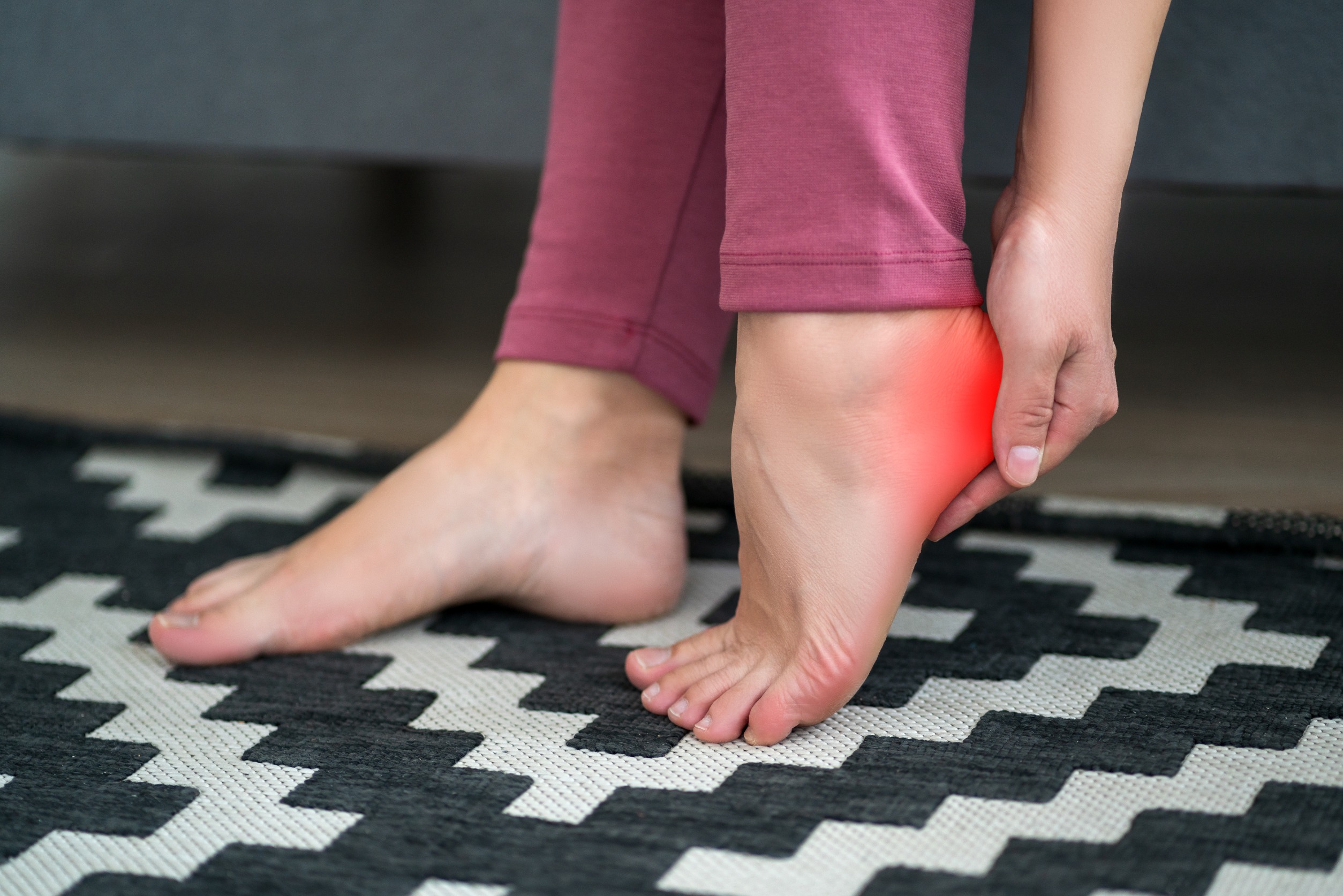Plantar Fasciitis
What is Plantar Fasciitis?
Plantar fasciitis is a common condition that causes heel pain due to inflammation of the plantar fascia—a thick band of tissue connecting the heel bone to the toes.

Symptoms of Plantar Fasciitis
The hallmark symptom is heel pain, particularly after taking the first steps in the morning or after extended periods of rest. The pain is generally located at the bottom of the heel.
Causes of Plantar Fasciitis
Plantar fasciitis often develops due to repetitive stress on the plantar fascia from activities like walking, running, or prolonged standing. Several risk factors contribute to its development:
- Foot Structure: Conditions like high arches or flat feet.
- Footwear: Unsupportive shoes, such as flip-flops or those lacking proper arch support.
- Obesity: Carrying excess weight strains the feet.
- Activities: Sports such as running or dancing, as well as jobs requiring prolonged standing.
- Age: More prevalent among middle-aged adults.
Treatment Options for Plantar Fasciitis
Patients have a variety of options to manage symptoms. Conservative measures include:
- Rest and activity modification
- Icing the affected area
- Orthotics for arch support
- Physical therapy to strengthen and stretch the fascia
Radiation Therapy for Plantar Fasciitis
For patients who do not find relief with conservative treatments, Low-Dose Radiation Therapy (LDRT) offers a promising, non-invasive option. Studies have shown that LDRT effectively reduces pain for a high percentage of plantar fasciitis patients.
How Does LDRT Work?
LDRT works by:
- Breaking down painful scar tissue in the heel and arch.
- Triggering a healing response, as damaged cells repair themselves.
This method allows for long-term pain relief without surgery or repeated injections.
Effectiveness of LDRT
Clinical studies indicate:
- Three months post-treatment, nearly 70% of patients report being pain-free or experiencing minimal discomfort.
- At 54 months, around 60% of patients remain pain-free or experience significantly reduced pain
Radiation Therapy for Plantar Fasciitis
Patients who fail conservative measures for Plantar Fasciitis can be excellent candidates for Low Dose Radiation Therapy (LDRT). It has been found that LDRT is an effective non-invasive treatment method for a high percentage of plantar fasciitis patients. When it comes to Plantar Fasciitis, low doses of radiation break down painful scar tissue in the heel and arch. The small dose of radiation can also trigger a healing response, as the cells that have just sustained some damage repair themselves. Studies have shown that three months after the course of radiation therapy, almost 70% were pain free or had very little pain. At 54 months, a little over 60% were still pain-free or almost pain free.
What is Plantar Fasciitis?
Plantar fasciitis is a common condition that causes heel pain due to inflammation of the plantar fascia—a thick band of tissue connecting the heel bone to the toes.

Symptoms of Plantar Fasciitis
The hallmark symptom is heel pain, particularly after taking the first steps in the morning or after extended periods of rest. The pain is generally located at the bottom of the heel.
Causes of Plantar Fasciitis
Plantar fasciitis often develops due to repetitive stress on the plantar fascia from activities like walking, running, or prolonged standing. Several risk factors contribute to its development:
- Foot Structure Conditions like high arches or flat feet.
- Footwear: Unsupportive shoes, such as flip-flops or those lacking proper arch support.
- Obesity: Carrying excess weight strains the feet.
- Activities: Sports such as running or dancing, as well as jobs requiring prolonged standing.
- Age: More prevalent among middle-aged adults.
Treatment Options for Plantar Fasciitis
Patients have a variety of options to manage symptoms. Conservative measures include:
- Rest and activity modification
- Icing the affected area
- Orthotics for arch support
- Physical therapy to strengthen and stretch the fascia
Radiation Therapy for Plantar Fasciitis
For patients who do not find relief with conservative treatments, Low-Dose Radiation Therapy (LDRT) offers a promising, non-invasive option. Studies have shown that LDRT effectively reduces pain for a high percentage of plantar fasciitis patients.
How Does LDRT Work?
LDRT works by:
- Breaking down painful scar tissue in the heel and arch.
- Triggering a healing response, as damaged cells repair themselves.
This method allows for long-term pain relief without surgery or repeated injections.
Effectiveness of LDRT
Clinical studies indicate:
- Three months post-treatment, nearly 70% of patients report being pain-free or experiencing minimal discomfort.
- At 54 months, around 60% of patients remain pain-free or experience significantly reduced pain
Radiation Therapy for Plantar Fasciitis
Patients who fail conservative measures for Plantar Fasciitis can be excellent candidates for Low Dose Radiation Therapy (LDRT). It has been found that LDRT is an effective non-invasive treatment method for a high percentage of plantar fasciitis patients. When it comes to Plantar Fasciitis, low doses of radiation break down painful scar tissue in the heel and arch. The small dose of radiation can also trigger a healing response, as the cells that have just sustained some damage repair themselves. Studies have shown that three months after the course of radiation therapy, almost 70% were pain free or had very little pain. At 54 months, a little over 60% were still pain-free or almost pain free.
Treatment Options for Plantar Fasciitis
Patients have a variety of options to manage symptoms. Conservative measures include:
- Rest and activity modification
- Icing the affected area
- Orthotics for arch support
- Physical therapy to strengthen and stretch the fascia
Radiation Therapy for Plantar Fasciitis
For patients who do not find relief with conservative treatments, Low-Dose Radiation Therapy (LDRT) offers a promising, non-invasive option. Studies have shown that LDRT effectively reduces pain for a high percentage of plantar fasciitis patients.
How Does LDRT Work?
LDRT works by:
- Breaking down painful scar tissue in the heel and arch.
- Triggering a healing response, as damaged cells repair themselves.
This method allows for long-term pain relief without surgery or repeated injections.
Effectiveness of LDRT
Clinical studies indicate:
- Three months post-treatment, nearly 70% of patients report being pain-free or experiencing minimal discomfort.
- At 54 months, around 60% of patients remain pain-free or experience significantly reduced pain
Radiation Therapy for Plantar Fasciitis
Patients who fail conservative measures for Plantar Fasciitis can be excellent candidates for Low Dose Radiation Therapy (LDRT). It has been found that LDRT is an effective non-invasive treatment method for a high percentage of plantar fasciitis patients. When it comes to Plantar Fasciitis, low doses of radiation break down painful scar tissue in the heel and arch. The small dose of radiation can also trigger a healing response, as the cells that have just sustained some damage repair themselves. Studies have shown that three months after the course of radiation therapy, almost 70% were pain free or had very little pain. At 54 months, a little over 60% were still pain-free or almost pain free.
What is Lung Cancer?
Lung cancer is the presence of a tumor in the lung as a result of an abnormal growth of cells. If these cells originated in the tumor, then it is known as primary lung cancer. If these cancerous cells originated in another organ and reached the lung through the bloodstream, then it is metastatic lung cancer.
The American Cancer Society projected 221,200 new cases of lung cancer and 158,040 deaths from the disease in the United States in 2015. Most deaths occur in patients with Stage III or Stage IV lung cancer.
Types
There are two types of lung cancer. The most common type is non-small cell lung cancer, such as squamous cell carcinoma and adenocarcinoma. The second and less common type is small cell lung cancer, which in the past was frequently referred to as oat cell cancer.
Risks
Smoking is the leading cause of lung cancer, resulting in 85% to 90% of all lung cancer cases. Other risk factors that contribute to the development of lung cancer include:
- Second-hand smoke
- Air pollution
- Asbestos
- Radon
- Tubercolosis
Signs and Symptoms
Though not everyone with lung cancer will exhibit symptoms, particularly in its early stages, there are some common symptoms to be aware of:
- Persistent cough
- Shortness of breath
- Coughing blood
- Chest pain
- Pneumonia or bronchitis
- Weight loss, lack of appetite, or fatigue
- Swelling of the neck and face
Detection
Typically, primary lung cancer does not cause any symptoms in its early stages. In many cases, the cancer has advanced when symptoms begin to occur. Many patients end up going to the doctor for a persistent cough, coughing up blood, shortness of breath, etc., and it usually these symptoms that can influence doctors to order a chest X-Ray, CT scans (Computed Tomography), PET-CT scans (Positron Emission Tomography-Computed Tomography), and MRIs (Magnetic Resonance Imaging). These scans and chest X-Rays can indicate the presence of cancer in the lung or in other parts of the body.
Diagnosis
Diagnosing lung cancer is then done by either performing a biopsy, examining a small piece of tissue, or by analyzing fluid to identify the presence of a protein specific to tumor cells. Doctors will then determine the stage of lung cancer by examining the size of the tumor and whether or not it has spread, and to what extent.












